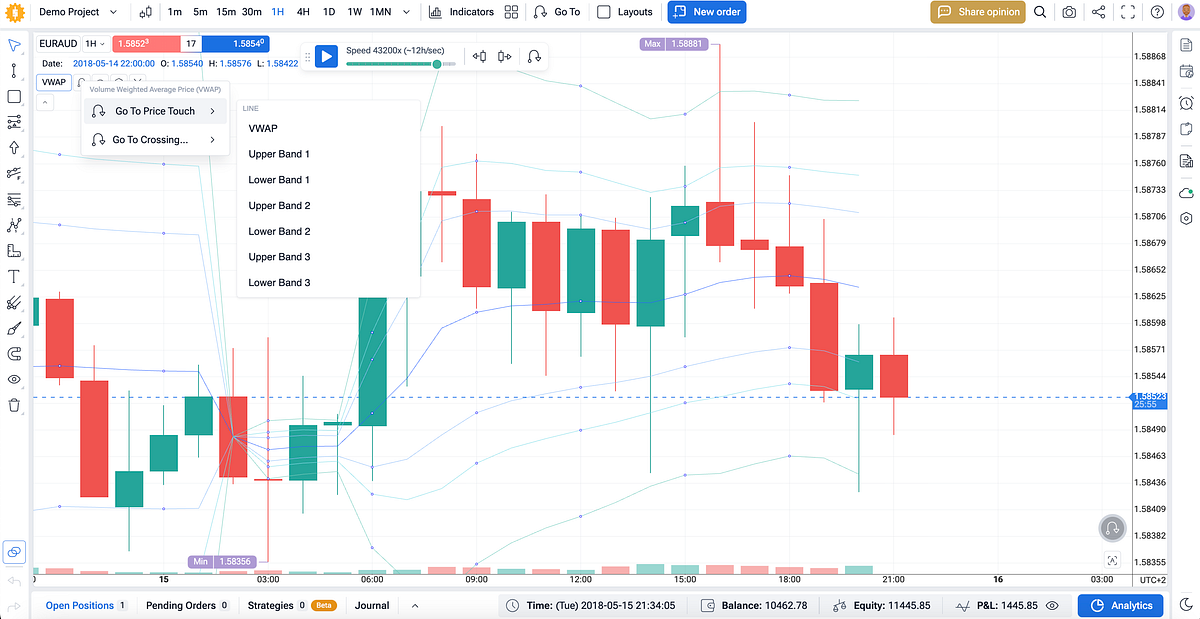I’ve used almost every popular trading and backtesting tools out there. Some were slow, some buggy, and some looked like they were built twenty years ago. Over the years, I narrowed it down to just a few that I actually use — one main backtester and a few tools that help me connect the whole trading process.
My main backtesting tool: Forex Tester Online (FTO)
If you’ve read my previous articles, you already know I’m a big fan of Forex Tester Online. It’s a browser-based simulator built specifically for testing strategies. It’s fast, intuitive, and works anywhere — even on a Mac or tablet.
What makes it stand out is realism. It uses tick-by-tick data, floating spreads, real commissions, and slippage. When you test a system here, it feels close to live trading. You can open and close orders right on the chart, set partial closes, breakevens, and trailing stops — all while watching the equity curve evolve in real time.
It also has a “Mystery Mode,” which hides dates and symbols so you don’t recognize familiar moves. This feature alone changed how I test — it completely kills bias.
The analytics are detailed: equity, drawdown, win rate, expectancy, MAE/MFE, and per-strategy stats. It’s not perfect — it’s for testing only, not for live trading, but that’s the point. It’s where you prove a system before risking real money.
I’ve tried backtesting in other tools, but FTO is the only one that actually feels like trading without the risk.
Tools that complete the setup
After testing, I still need charts, a journal, and a way to stay aware of market events. These three tools fit perfectly around FTO.
TradingView
TradingView is where I do all my live charting. I don’t use it for backtesting — its strategy tester is too simplistic and ignores real trading costs — but it’s great for planning setups, marking zones, and setting alerts. Its interface is smooth, and I can track everything across multiple devices.
I don’t backtest here. I use it for live charts, watchlists, and alerts.
Pros
- Fast charts, clean drawings, custom layouts.
- Alerts on price/indicator levels so I don’t babysit screens.
- Easy to keep the “big picture” while I test details elsewhere.
Cons
- Strategy tester is too basic for forex slippage/spread realism.
- I treat it as charting, not as a tester.
Use case
- Mark levels, set alerts, track context while FTO handles the heavy testing.
Myfxbook
Then comes Myfxbook, or any serious trading journal. This is where I verify how my backtested ideas behave in live conditions. After I pass a system through FTO, I forward-test it on demo, track it in Myfxbook, and see if the live results stay close to what the simulator promised. It also exposes my behavioral mistakes — overtrading, bad timing, and missed stops.
Once a system passes backtests, I forward-test it and log every trade.
Pros
- Auto-import from brokers, quick stats, equity curves, error spotting.
- Tags and notes to match live errors with backtest rules.
Cons
- Junk in, junk out. If you don’t tag and comment, you learn nothing.
Use case
- Confirm that your backtest survives real spreads, slips, and your own execution.
Forex Factory Calendar
Finally, I keep an eye on the Forex Factory Calendar. It’s not fancy, but it’s essential. Big news releases are still one of the easiest ways to get stopped out. I use it to avoid opening trades around events like NFP or CPI. It doesn’t make me money, but it helps me keep what I already made.
Backtests are cleaner when you add a news filter. Live trading too.
Pros
- Fast read on high-impact events (CPI, NFP, central banks).
- I avoid opening new risk 10–15 minutes before the red events that smash my style.
Cons
- Not a trading edge on its own. Just keeps you out of avoidable hits.
Use case
- Add a simple rule: no fresh entries into top events; manage open risk ahead of them.
How I actually use them together
I usually start with a rough idea — for example, an MA breakout system or a pullback entry with RSI confirmation. I run it in Forex Tester Online across multiple pairs and years of tick data. If the results look decent and drawdowns stay within reason, I test it live with small size.
While I trade, TradingView keeps me visually connected to the market, Myfxbook tracks the numbers, and the calendar reminds me when to stay flat. Over time, I compare live equity to simulated equity. If they’re close, the system is solid. If not, I go back to FTO, tweak rules, and test again.
It’s a continuous loop: idea, then backtest, then forward test, review, and (if needed) refine.
My main takeaways
Backtesting software doesn’t make you a profitable trader. It just tells you the truth — if your strategy works, or if you’ve been fooling yourself. Before using FTO, I spent months trying to test manually on live charts. It was slow and inconsistent. With a proper simulator, I could compress years of learning into days.
TradingView, Myfxbook, and the calendar are not “alternatives.” They’re extensions of the same process — analysis, execution, reflection, and discipline.
If I had to start over, I’d still begin with Forex Tester Online. It’s the foundation. Then I’d use TradingView to track setups, Myfxbook to measure progress, and the calendar to stay out of trouble.
These four tools, together, make trading more structured, objective, and predictable — exactly what it should be.
Follow for more stories from my trading experience
Learn more about Best Backtesting Tools for Forex
